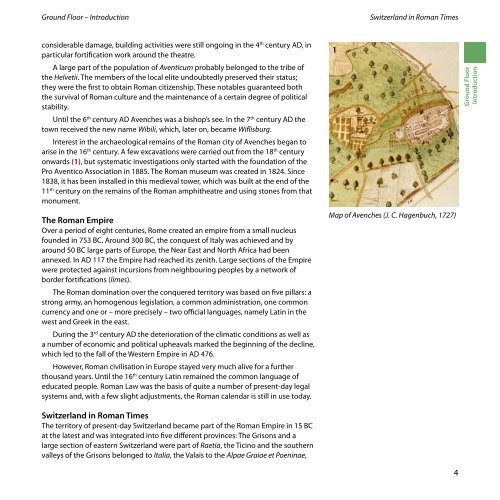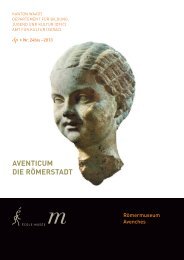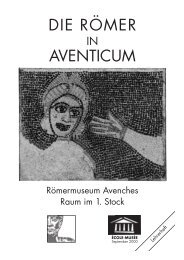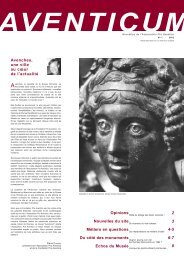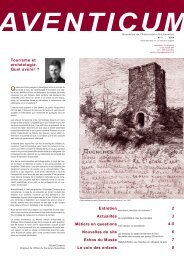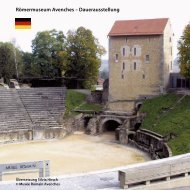Avenches – Roman Museum – Permanent Exhibition
Avenches – Roman Museum – Permanent Exhibition
Avenches – Roman Museum – Permanent Exhibition
Create successful ePaper yourself
Turn your PDF publications into a flip-book with our unique Google optimized e-Paper software.
Ground Floor <strong>–</strong> Introduction Switzerland in <strong>Roman</strong> Times<br />
considerable damage, building activities were still ongoing in the 4 th century AD, in<br />
particular fortification work around the theatre.<br />
A large part of the population of Aventicum probably belonged to the tribe of<br />
the Helvetii. The members of the local elite undoubtedly preserved their status;<br />
they were the first to obtain <strong>Roman</strong> citizenship. These notables guaranteed both<br />
the survival of <strong>Roman</strong> culture and the maintenance of a certain degree of political<br />
stability.<br />
Until the 6th century AD <strong>Avenches</strong> was a bishop’s see. In the 7th century AD the<br />
town received the new name Wibili, which, later on, became Wiflisburg.<br />
Interest in the archaeological remains of the <strong>Roman</strong> city of <strong>Avenches</strong> began to<br />
arise in the 16th century. A few excavations were carried out from the 18th century<br />
onwards (1), but systematic investigations only started with the foundation of the<br />
Pro Aventico Association in 1885. The <strong>Roman</strong> museum was created in 1824. Since<br />
1838, it has been installed in this medieval tower, which was built at the end of the<br />
11th century on the remains of the <strong>Roman</strong> amphitheatre and using stones from that<br />
monument.<br />
The <strong>Roman</strong> Empire<br />
Over a period of eight centuries, Rome created an empire from a small nucleus<br />
founded in 753 BC. Around 300 BC, the conquest of Italy was achieved and by<br />
around 50 BC large parts of Europe, the Near East and North Africa had been<br />
annexed. In AD 117 the Empire had reached its zenith. Large sections of the Empire<br />
were protected against incursions from neighbouring peoples by a network of<br />
border fortifications (limes).<br />
The <strong>Roman</strong> domination over the conquered territory was based on five pillars: a<br />
strong army, an homogenous legislation, a common administration, one common<br />
currency and one or <strong>–</strong> more precisely <strong>–</strong> two official languages, namely Latin in the<br />
west and Greek in the east.<br />
During the 3rd century AD the deterioration of the climatic conditions as well as<br />
a number of economic and political upheavals marked the beginning of the decline,<br />
which led to the fall of the Western Empire in AD 476.<br />
However, <strong>Roman</strong> civilisation in Europe stayed very much alive for a further<br />
thousand years. Until the 16th century Latin remained the common language of<br />
educated people. <strong>Roman</strong> Law was the basis of quite a number of present-day legal<br />
systems and, with a few slight adjustments, the <strong>Roman</strong> calendar is still in use today.<br />
Switzerland in <strong>Roman</strong> Times<br />
The territory of present-day Switzerland became part of the <strong>Roman</strong> Empire in 15 BC<br />
at the latest and was integrated into five different provinces: The Grisons and a<br />
large section of eastern Switzerland were part of Raetia, the Ticino and the southern<br />
valleys of the Grisons belonged to Italia, the Valais to the Alpae Graiae et Poeninae,<br />
1<br />
Map of <strong>Avenches</strong> (J. C. Hagenbuch, 1727)<br />
4<br />
Ground Floor<br />
Introduction


